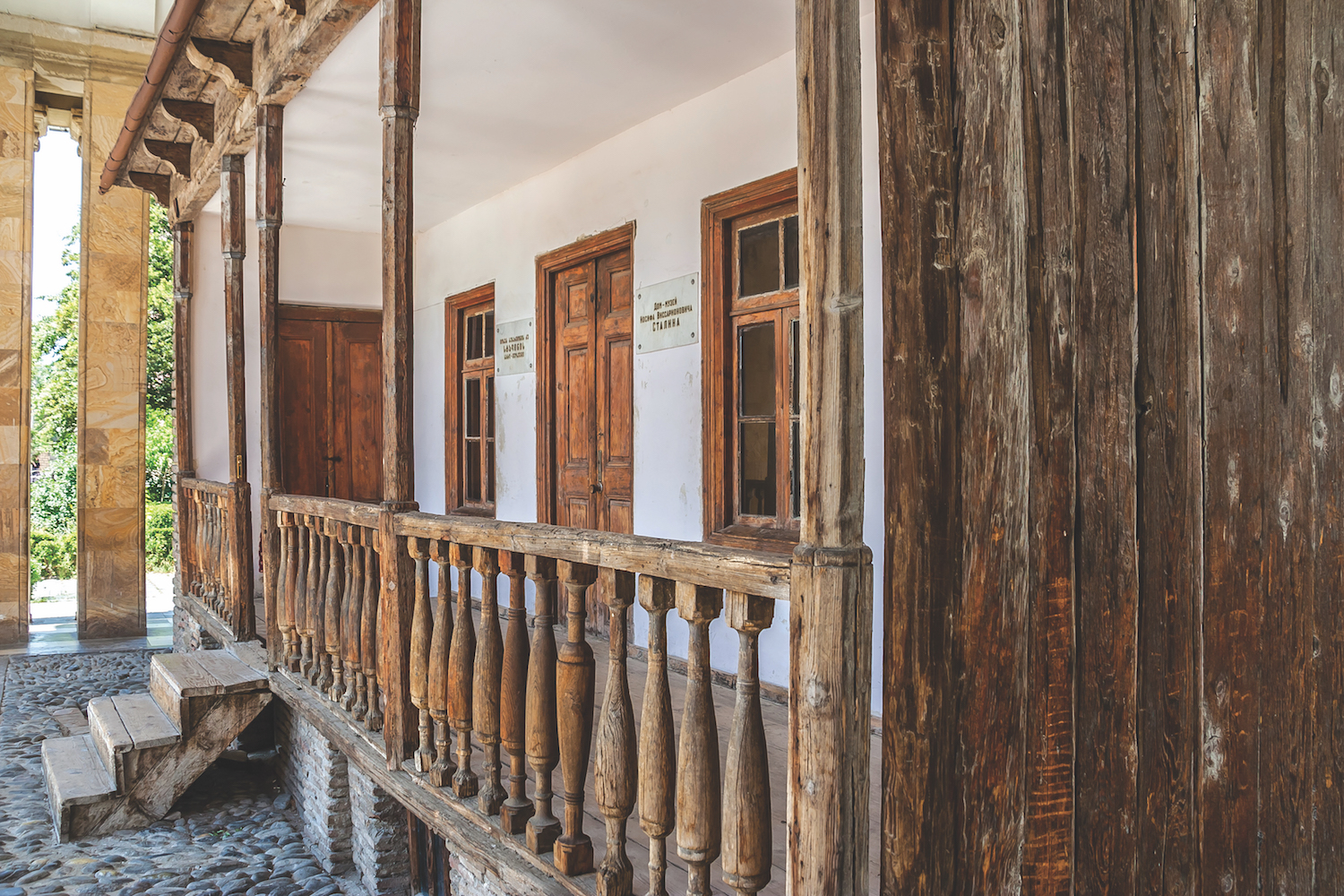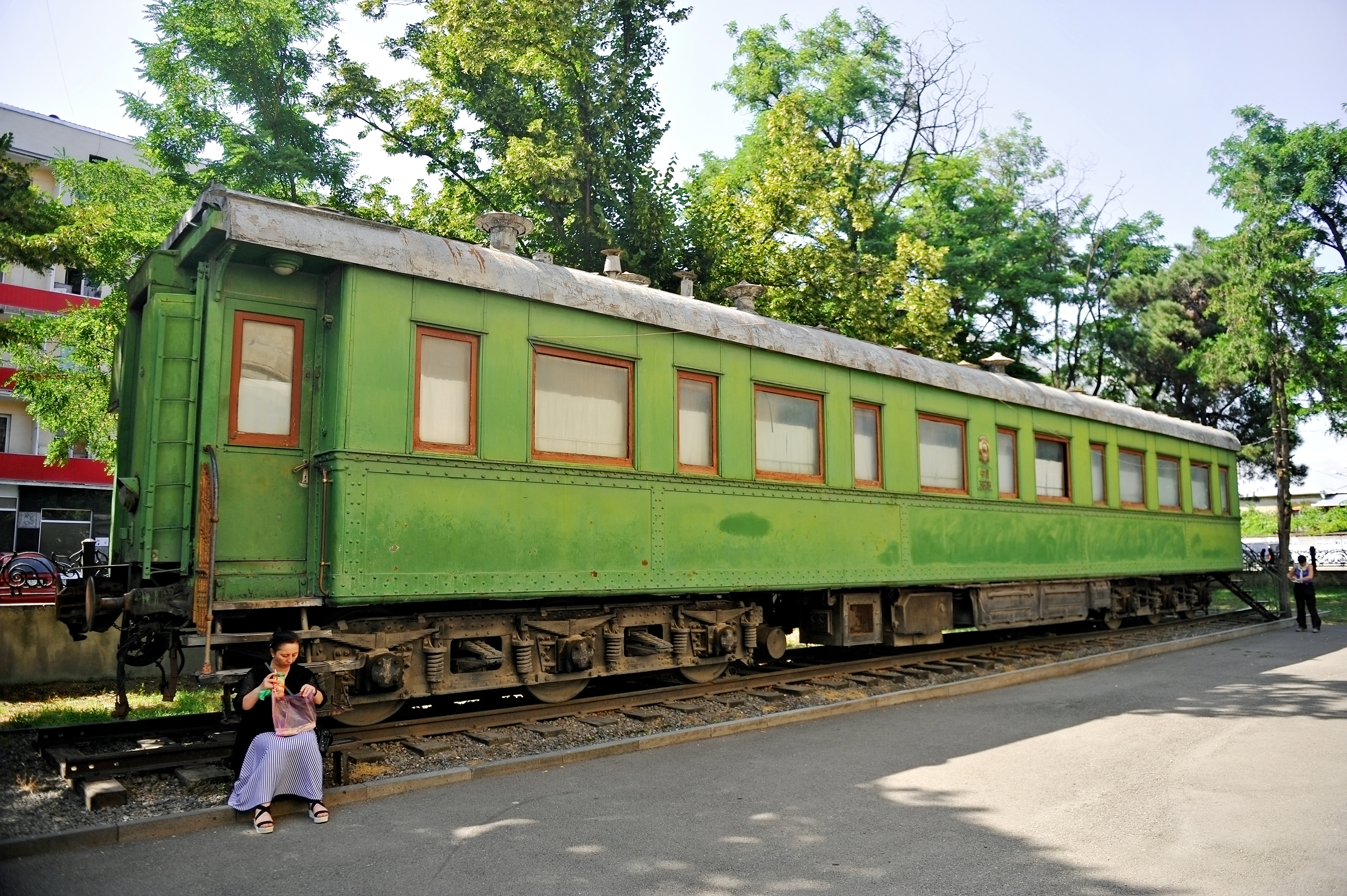Stalin Park in Gori, Georgia, is a quaint triangle of grass lined with trees and shrubs, where tiny pedestrian bridges arc across a reflecting pool ringed with off-white laid brick. Standing guard at the north end of the park is an imposing statue, 12 feet or more in height, of Joseph Stalin in knee-high boots, trousers, and a military tunic buttoned all the way to the neck. A few hundred feet away stands the forest-green, heavily armored railway carriage car Stalin rode to the Yalta and Potsdam conferences, where he established the post-World War II order with world leaders such as President Harry S. Truman and British Prime Minister Winston Churchill. Behind the statue sits Stalin’s childhood home. I’m at the Joseph Stalin Museum in Gori, a tribute to the city’s most famous son, the mass murderer and Soviet Union leader born here nearly 140 years ago as Iosif Dzhugashvili.
Many in Gori still revere Stalin. His museum here is a shrine, a tribute to a man whose rule many of us associate with one of the most murderous regimes in modern history. With its cabernet-colored carpets and walls, its larger-than-life photos of a stoic Stalin, and its blown-up documents and newspaper clippings trumpeting his accomplishments (if that’s the word), the museum almost feels like an alternate reality. Though 80,000 Georgians were killed and a majority of the 400,000 deported were retried and executed under Stalin’s policies, the entire museum notes just 12 of them, in a tiny display case.
So why do the citizens of Gori maintain such a rosy view of Stalin?

“Because he was Georgian,” my tour guide, Natia, answers matter-of-factly as we walk up the wide marble stairs in this frigid museum, where the only natural light comes from what few rays can penetrate the wrought-iron bars that cover the stained-glass windows. “He built factories here,” she continues, in a cheerfully revisionist interpretation of forced-labor camps. “If people didn’t have a job, they would arrest them and give them a job.”
Don’t take it from Natia alone—as recently as 2012, 45 percent of Georgians “express[ed] a positive attitude” toward Stalin, according to a survey by Carnegie Europe. Age divides Georgians on this question: Pensioners hold a more favorable view of Stalin, while younger generations are largely indifferent, or else feel more negative. (City-dwellers and more educated people also hold Stalin in lower regard to a statistically significant, but not major, degree.)
Perhaps that division is not entirely different from parallel historical disputes in other countries. Around the world, societies tend to split along social, class, and ethnic lines in their understandings of which leaders or causes were good and which were bad. How we reckon with a controversial national past will often depend on whether the group to which we or our ancestors belong benefited from that history, or identified with its avatars. Whether it’s Confederate monuments being torn down in the United States or Soviet statues being removed in Ukraine, this debate has assumed renewed significance in an era of rising nationalism that has picked old wounds and opened new ones, forcing people to confront national myths—or else to double down on them.

(Photo: The Voorhes)
An hour and change southeast of the Stalin Museum, the Museum of the Soviet Occupation in Tbilisi offers a study in contrast, and suggests the possibility that remembering the wrongs of our national pasts can also build understanding and cross-cultural healing. During a time when some national leaders appear to build strength from stoking racial, ethnic, and tribal conflict, the Museum of the Soviet Occupation aspires to stand as a monument to unity.
The Museum of the Soviet Occupation is decidedly anti-Communist, and its exhibits address Stalin’s atrocities without mentioning his name all that often. It begins with a wall that lists the numerous Georgian public figures killed during Soviet rule, a photo of mass murder with bodies lying on the ground, and a wall-sized photo honoring the “ruthlessly persecuted” Georgian aristocracy, while a video of the 2008 Russian incursion plays on loop to pre-recorded chants of “No Russia!” As the exhibit reminds us, Georgia had enjoyed not even three years of independence from the Russian Empire before a Bolshevik raid in 1921 helped put it into subjugation to the USSR for 70 years.
The museum is filled with original documents like Georgia’s declaration of independence, draft constitutions, and diaries of Georgian elites and founding fathers. There are rolls of members of the national-liberation movement shot and deported by troikas and the KGB, along with photos of various clergy, aristocrats, rebels, and others shot and killed. A prominent sign in bold capital letters states, “From 1942 to 1952 more than 5,000 persons were shot in Georgia, and 190,000 were deported.” Stalin died in 1953. The dark room with its rows of photos, letters, and artifacts seems to personalize the shared trauma that Georgians endured. The museum levels the divisions of clan and class. All affected were Georgian, and that’s all that matters.

“Most people, in fact, will not take the trouble in finding out the truth, but are much more inclined to accept the first story they hear,” Thucydides wrote in his History of the Peloponnesian War. Yet it is not enough merely to investigate the reality of the past, however ugly. It is the duty of both historians and citizens to prevent the horrors of the past from re-emerging in the present. Only by confronting historical wrongs can a people, a nation, avoid repeating them in the future.

But if one’s inclination is to prefer one’s own version of history—the period of time when a ruler or figurehead blessed one’s partisans with favoritism, or when that head of state was “one of us”—how can a country ever move forward?
“The fact that a society has problems or experiences or challenges that need time to deal with such legacies isn’t surprising,” says Tarik Cyril Amar, a professor of history at Columbia University whose research focuses on Ukraine. “The bigger question is, how are these challenges faced? You can’t just rely on time. In time itself something has to happen, certain initiatives have to be undertaken, activities must occur. Time itself doesn’t somehow improve things.”
Sixty-five years after Stalin’s death, the Stalin Museum in Gori lays these difficulties bare.
Of the dozens of photos of Stalin in this museum, just one shows him in true form, with the scars that covered his face—a symptom of the smallpox he suffered as a child. But that photo didn’t come from any local media. It was published in Life magazine.

Media, of course, was state-controlled in the former Soviet Union. In the post-Soviet years, Georgia has slowly come to embrace the idea of being unshackled from speech restrictions. It wasn’t too long ago—the 1990s—when Moscow still dictated what students in Georgia learned in their school texts. The Stalin they learned of was much different from the version that Georgians read about today. My tour guide Natia says she learned this rosier history of Stalin as she went through school, though as she tells me, “To work here you have to know both sides.”
“[The] new generation today, they don’t like Stalin,” she adds, qualifying her statement to note that people in Gori of all ages generally still view him more kindly than the rest of Georgia does. “Today in university they only study the negative part of the Soviet Union.”
The question of how one society could arrive at such diametrically opposed visions of its own history is one that vexes not just Georgia, Amar reminds me. He also says it’s important to keep in mind just how recently the Soviet Union ruled Georgian life.
Some countries, like South Africa, have investigated their collective memories through painful truth-and-reconciliation commissions. Still others are grappling with their occupied pasts. Rather than leave street names honoring Communist overseers intact, Poland and Ukraine are renaming some to reflect modern, nationalistic heroes. That’s causing its own problems: Many of those modern figures rose to power, in part, by oppressing ethnic and religious minorities. Certain nations are finding crafty workarounds. Lithuania, for example, is erecting signs alongside some Soviet monuments, in addition to dismantling others altogether.
“That’s what makes it so difficult, because when a society comes out of a situation like that,” Amar says of these scarring, fractious periods, and “tries to come to terms with” their legacy, there is “always a great temptation to imagine all of the society as simply victims. And it’s a great temptation to assume that everything that was done to us, the victims, came from outside.”
The Stalin Museum feels like a firm denial that the evil could ever have come from the inside—from a boy born here, in Gori. Two circular rooms toward the end of the tour epitomize the museum’s sense of absolute fealty to Stalin. The first features sepia-toned wall-length photos of triumphant Soviet soldiers, while a collage of photos of Stalin, from various stages of his life, ring the ceiling as trim for this eerie wallpaper. In the next circular room, its floor covered in what had now become that familiar cabernet carpet, the death mask of Joseph Stalin rises from a hole in the floor, bordered by a thin colonnade, with the overhead light shining like a spotlight on his likeness. On the back wall looms a painting of Stalin lying in state.

After allowing me to linger for what seems like an excessive length of time—waiting, no doubt, for me to experience a moment of epiphanal reverence—Natia whisks me quickly downstairs into a tiny room to close out the tour.
The last room is a replica of a secret police office, which Natia acknowledges is the museum’s minimal attempt to offer a balanced view of Soviet rule under Stalin’s leadership. It has the vibe of an afterthought, this little fake jail cell with a desk and a document commanding someone’s murder, plus some anachronistic photos of the 2008 Russian incursion into Georgia.
Natia makes no attempt to play up this portion of the museum, and her closing words convey the unsettling suggestion that competing versions of history come down to something like consumer choice: “If you’re more interested in the negative side of the Soviet Union, you can visit the Museum of Soviet Occupation in Tbilisi,” she says, ending the tour.
A version of this story originally appeared in the June/July 2018 issue of Pacific Standard. Subscribe now and get eight issues/year or purchase a single copy of the magazine. It was first published online on May 23rd, 2018, exclusively for PS Premium members.





